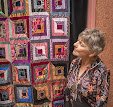PATCHWORK ON THE SILK ROAD
Up-Cycling in the Ninth Century
In case we thought that making do and
mending – currently more trendily known as ‘re-purposing’ or ‘up-cycling’ – was
a relatively recent idea, some surviving ancient textiles prove that it is a
concept which has been around for many centuries, although the motivations for
it have been, and are, many and various. A silk valance* dating from the
C9th/C10th, an example of a Buddhist devotional object, is a case in point. It
was found in 1907 by the Hungarian-British explorer and archaeologist, Sir Marc
Aurel Stein, in a previously sealed cave, designated Cave 17, connected to the
now famous complex known as the Caves of a Thousand Buddhas in Dunhuang,
Stein found three valances in Cave
17, two of which are in
As well as the valances, the caves contained other examples
of silk patchwork in various states of preservation. Patchwork has historically
had an important role in Buddhist practice, stimulated by the Buddha’s precept
against waste. As a result, to piece together patches of valuable silk was seen
as an act of serious piety. Silk fabrics were given as votive offerings by
affluent visitors to the shrines, some perhaps spontaneously torn from their
own clothing.
The way in which this valance, and
many other artefacts from Dunhuang, ended up in western museum collections is
in itself a fascinating story. Stein was
but one of many western explorers and archaeologists who, from the end of the
nineteenth century, heard rumours of manuscripts and artefacts being offered
for sale in local markets in Western China and set out to acquire whatever
treasures they could find. Their activities eventually led the Chinese authorities
to clamp down on ‘foreign devils’ simply loading their finds onto camels and
horses and transporting them back to the West. But that clamping down didn’t
happen until the 1930s, by which time many thousands of items had been acquired
by museums both in the
Aside from their significance to contemporary patchworkers,
the silk patchworks found at Dunhuang are a valuable contribution to the
broader research into the subject of textiles on The Silk Road.. They provide
unique insight into the probable uses and religious significance of found
objects, as well as proving that certain construction and needlework techniques
have been used over many centuries. Study of the fabrics yields information
about types of silk, their geographical origins and manufacturing techniques.
In 1994 the British Library established the
International Dunhuang Project, a collaborative effort to conserve, catalogue
and digitize manuscripts, printed texts, paintings, textiles and artefacts from
the caves at Dunhuang and various other archaeological sites from the eastern
end of The Silk Road.
Further reading and
information
Aurel Stein on the Silk Road by Susan Whitfield, The British Museum London
Foreign Devils on the Silk
Road London
The International Dunhuang Project Online: http://idp.bl.uk
Thanks to Dr Luk Yu-ping, Basil Gray Curator: Chinese
Paintings, Prints and Central Asian Collection at the British Museum


No comments:
Post a Comment